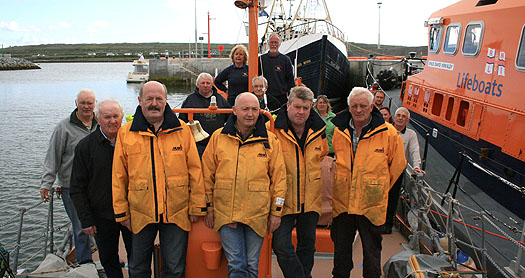#RNLI – A surprise return visit to the Aran Islands was made recently by former Galway Bay RNLI lifeboat Frank Spiller Locke. This restored Barnett class lifeboat was stationed at the Aran Islands from 1977 to 1985. She was previously stationed at Weymouth on the south coast of England. During her years of lifeboat service she was launched 396 times and saved 181 lives.
The lifeboat was funded through a legacy from Dr. Frank Spiller Locke. RNLI records show that his widow Mrs E. F. Locke took a strong interest in the work of the lifeboat and her volunteer crew and asked for the returns of service for every callout to be sent to her until her death.
The vessel was built in Cowes during 1958 at a cost of £38,500. It was a Barnett class lifeboat, which was introduced into the RNLI in 1950. Twenty of these 52 ft lifeboats were built by the charity. The institution retired and sold this lifeboat in 1986 and she was rescued sometime later by Colin and Janet Sturmer who are from the Isles of Scilly. They dedicated ten years to restoring this boat to its original form.

Pictured on the deck of the former Galway Bay lifeboat in yellow jackets are members of the current Aran Islands RNLI crew who also served on the Frank Spiller Locke lifeboat (L-R) Mairtin Fitz, Micheal O Goill, Johnny Mulkerrin, Enda Mullen.
"It was a lovely surprise to see this lifeboat in the Bay where she used to anchor in the 1980s" said Micheal Heron Aran Islands RNLI Lifeboat Operations Manager.
The two lifeboats, retired and current were moored side by side so that past and present crew could look over it. Four of the current lifeboat crew who served on the Frank Spiller Locke, Mairtin Fitzpatrick, Michéal Ó Goill, Johnny Mulkerrin and Enda Mullen, were joined by retired crewmembers Paddy Mullen, Bartley Mullen (Coxswain/Mechanic), Jackie Gill and Tomas Kelly. Many local people also came for a look and remembered stories of times that they or their families needed this lifeboat
Commenting on the visit, serving crewmember Micheal Gill added "there are a lot of differences in the speed and technology of these older boats. She served the west coast well at a time when there were only three lifeboats from Donegal to South Kerry and no helicopters.
This boat is a valuable piece of our maritime heritage, which has been lovingly restored bye Colin and Janet. Hopefully it will visit the west coast again in the future."































































